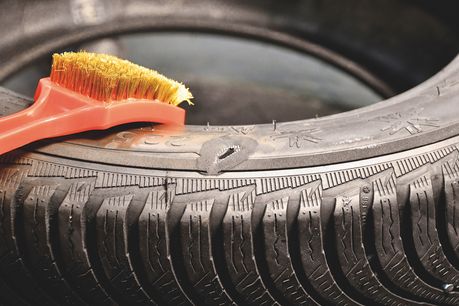Newsroom
Sustainably Reducing CO2 Emissions: Tire Repair as the Key to more Environmentally Friendly Mobility

Poing, near Munich, September 9th, 2024. More than 300 million car, light commercial vehicle and truck tires are changed every year in Europe to replace worn or defective tires, about 45 million of them in Germany alone. The majority of car drivers and many commercial enterprises still leave a lot of potential savings for the environment and mobility costs untapped. With professional system solutions for the repair and retreading of tires for passenger cars and trucks as well as industrial, agricultural and off-the-road vehicles, REMA TIP TOP, based in Poing near Munich, is promoting a sustainable tire cycle that reduces costs and raw material consumption.
"Retreading worn tires and repairing defective tires is an ecologically and financially unparalleled alternative to new tires," says Gerhard Hieber. He is Product Manager at REMA TIP TOP, a network partner of Allianz Zukunft Reifen (AZuR, translates as Alliance for the Future of Tires). As one of the world's leading manufacturers of tire repair systems, REMA TIP TOP supports the AZuR network's long-term goal of reusing or recycling 100 percent of tires after their first use cycle. Education and training in the field of tire repair also play an important role. For this reason, REMA TIP TOP trains companies in the use of various repair systems at the REMA TIP TOP Academy in Poing near Munich.
Each year, an estimated four million drivers in Germany experience tire damage. All it takes is a nail on the road or contact with a curb. Gerhard Hieber assumes that in more than 1.5 million of these cases, a repair is technically possible and also makes economic sense given the expected mileage. And without compromising safety. This includes punctures in the tread or damage to the sidewall.
"Repaired tires offer the same level of safety as new tires, even at high speeds and torques. This is ensured if the damage is properly assessed and the repair is carried out in a specialized workshop.” The classic damage patterns with an expansion of 3-6 mm can be repaired quickly and cost-effectively with the TÜV-certified MINICOMBI system, manufactured by REMA TIP TOP in Germany. Hot vulcanization is used for larger punctures up to 10 mm. The resource and cost benefits of tire repair are significant. Since a defective tire usually has to be replaced on every axle, new tires can cost up to €100 or even €200 more, depending on the tire size and performance class.
Innovations are also providing ever better arguments for tire repair. As part of its ongoing product development, REMA TIP TOP was the first supplier in the world to launch a tire repair patch with a bimodal bonding layer, which is characterized by exceptionally high initial adhesion and significantly improved structural strength. In terms of sustainability, there is also an important trend towards solvent-free tire repair. Tire repair is positive for the environment anyway. Gerhard Hieber: “According to our calculations, the manufacture and disposal of a tire produces 44 kg of CO2. In Germany alone, tire repairs could save over 32,000 tons of CO2 emissions every year.”
The environmental factors have an even greater impact when retreaded tires are used. According to an AZuR/DBU study by the Fraunhofer Institute for Environmental, Safety and Energy Technology UMSICHT, retreaded tires cause over 63 % less CO2 emissions during production than high-quality new tires of comparable quality. With an identical rolling resistance class and comparable mileage, retreads do not consume any more energy than new tires.
At the same time, Gerhard Hieber clears up misconceptions that many drivers still have. Safety is not an issue with refurbished tires. For decades, they have been subject to the same strict quality requirements in accordance with UN-ECE Regulations 108 and 109, which guarantee one hundred percent recovery and take into account the specified speed and load indices. Another interesting fact: while a car tire can be retreaded a maximum of once, truck tires can be given a new life three times. In aviation, on the other hand, with its particularly stringent safety requirements, a tire can be retreaded more than six times.

